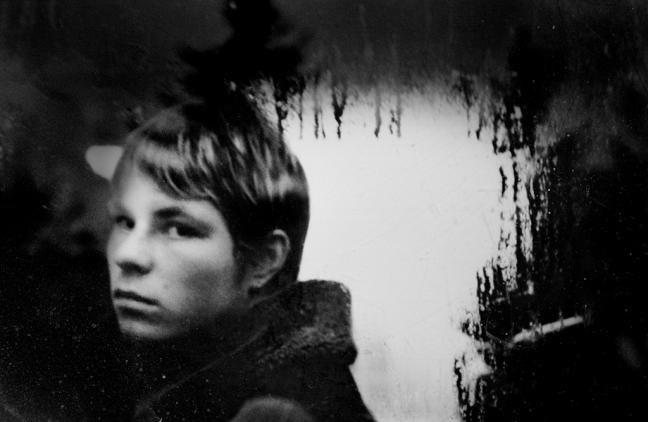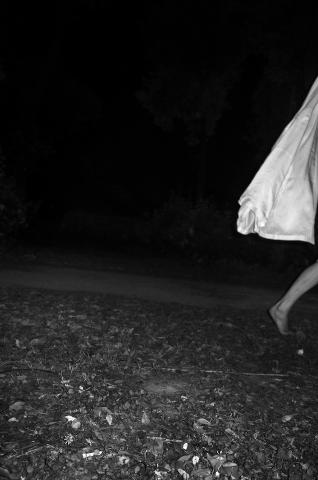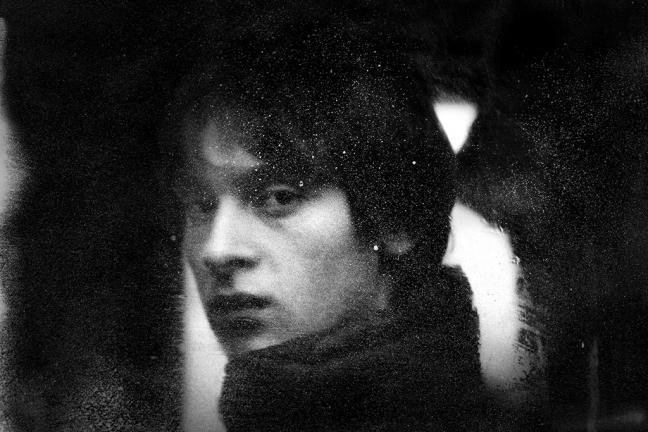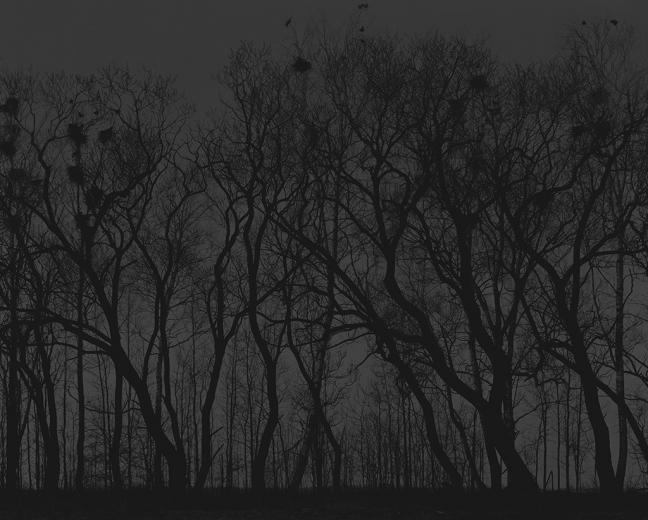
Alexandra Catiere’s work is nourished by traditional photography methods, creating images that mature slowly, from the shot to the dark room. She takes everyday situations and produces images with distance, poetic, out of time pieces that go beyond their subject. She suggests the fleeting and fragile nature of existence, the interiority of beings. Originally from Belarus, Alexandra Catiere has successively worked and lived in Russia, the United States and France. Her wanderings have led her to question the way humans live on earth and the fleeting nature of all things, beyond any kind of culture.
Alexandra Catiere’s photography is a process, a slow method from which the images emerge. It involves abandoning mentalisation and giving in to the present, to what is. Her technique is traditional, for the most part, requiring latency, exposure and experimentation in the dark room, where the images appear as a continuation of the taking of the shot itself. In the dark room there are no reference points, a new timeline sets in: without daylight, photographic time takes over from normal time. The perception of space becomes functional, creating more of a tactile process than a visual one. Cutting herself off from the world and leaning into solitude take her to a place where she can test, handle and combine her pieces. Photography becomes a material,
a substance that invites the examination of the tenuous.
Remembering her time as artist in residence at the musée Nicéphore Niépce in 2011, the artist got the urge to re-examine the digital printing of photos that were taken and developed in the traditional way. For some pieces she mixes different processes but
the maturing period never changes. The methods are mechanical of course, but her technical mastery gets transposed into the new tool which expands its possibilities, offering a change of format, a broader vision. No longer hemmed in by what photographic paper is available or what can be done with an enlarger, the size
of the prints raises other issues of scale.
The Behind the glass
series dates from a period spent in Minsk and Moscow in 2005 and 2006. Catiere returned to her native country after a period spent in the United States, eager to develop a long-gestated project. But despite her enthusiasm, reality did not match up to her hopes. She put the planned project aside and decided to open up, to become more receptive to her surroundings. She set up at a bus stop, observing the passengers inside the vehicles. They were, like her, in transit: in between two places, in a country that was undergoing major changes with an uncertain future. Using a 35mm camera, she shot passengers through a rain-covered bus window, using this banal, everyday situation to capture an in-between time where fatigue and sadness come to the surface. Sometimes the subject’s eyes focus on the photographer.
The moment is so fleeting that there is no need for pretence or social niceties. The subjects look directly at the camera, but seem to go beyond us, to go through us. Time and geography no longer exist. Inner truth seems eternal in this challenge that uses
no artifice. The photographs capture everything on the window in equal measure, rivulets, projections, drops… The almost pictorial rendering of the scene in black
and white, adds a certain distance and depicts the separation between the photographer and the photographed. We are struck by the faces perhaps because the passengers are present with themselves rather than outside, as they are protected from the world by the window. There is no need to worry about being seen in a society where the face has become omnipresent in advertising, the media and merchandise.
The same examination of the inner self also features in Margaret
, a backlit, closely-framed portrait of a woman that gives a mirror effect, where only the woman’s hair
is revealed by the light. The face is taken over by shadows, an invitation to consider
that which is unexpressed, to explore and experience intimacy, with no way out.
Alexandra Catiere’s photographs are silent and out of time. In capturing the fleeting nature of an instant, she fixes it in a pictorial eternity. She materialises a tipping point after which anything can happen. In City at night
, the darkness is punctuated with just
a few city lights. The darkness is dense, almost omnipresent. The still sense of calm will soon change in the early traces of dawn. The night calls for the day. Black and white do not go together, they oppose one another. Alexandra Catiere uses the basics of photography in her own intense manner. Reality no longer exists (it only did for an instant) or more accurately, it no longer appears in a realistic way. Darkness and light increasingly take over.
Nature is very present. Catiere focuses on details (Herbs
) and photographic effects using matter and light (The sea, The river)
. She eliminates the horizon of representation and plays with formats, leaving the viewer without any spatial references. Her pieces create their own balance in these pieces of nature. Realism takes a back seat
to feelings and emotions, allowing the invisible to be perceived.
Catiere pushes this idea to the edge of abstraction in her photograms. Natural elements placed on light-sensitive paper take on a new life when exposed to the light. Prints, traces and materials blend with physical and chemical effects, creating images
of emotions, stirring up our senses, summoning introspection and deep thought.
This is what guides the work of Alexandra Catiere. She uses the possibilities of the medium to create living images that go beyond the mere transcription of the subject. Her pieces go beyond the scenes represented, allowing the viewer to perceive the fragility of existence, that which is fleeting, invisible, a spiritual emotion anchored in
the now. The artist’s different series are deliberately mixed up and put together
to create a coherent whole that is led by the transcendent question of our time on earth. Alexandra Catiere observes life like she would a star-filled sky: conscious
of admiring bodies whose light is proof of a presence yet signifies something finite.
« The constellation of these photographs creates a new portrait of life as it travels across our path. Where do we go and what do we leave behind us? »
(Alexandra Catiere)
Caroline Lossent

If the photography of today is all about bright colours, big formats and mass distribution, if magazines, advertising and social media manufacture spectacular, interchangeable and repetitive images, if intelligence is losing ground to vulgarity,
then Alexandra Catiere is an anachronism.
Film is outdated! Black and white is yesterday’s news! Introspection and poetry are stale and pretentious! But, over the past ten years as her work has taken shape, as her approach has asserted itself, Alexandra Catiere has never stopped exploring
the aesthetic possibilities of so-called traditional photography.
Photography for Catiere is a means of getting closer to nature, to grasp the body and soul, to express its sensibility and to touch ours. She goes against the grain of today’s world, she knows how to take her time and invest her passion for humanity in every stage of the making of a photograph: seeking out a subject, coming back to it, waiting for just the right time to press the button, then developing the film, making the print
with the enlarger and the baths, going in different directions, thinking about the format…
Alexandra Catiere finds and reveals herself in the intimacy of the dark room.
She is never alone in there, she has her paper, her baths, her fixers… Like a timeless photography genius, she plays with chemistry and matter to produce her profoundly humanist world vision.
The apparent simplicity of her subjects and compositions vibrate with empathy and humanity, each snatch of the real means a dual introspection for the artist: hers
and that of the viewer. This inner voyage appears self-centred but is, in fact, eminently intimate, and it touches on the universal. Her portraits show each subject seem to turn into themselves, showing febrility and strength. The latent, muffled fragility of looks
and posture. Balancing on the tense thread of our certainties, a shift feels imminent; Behind the Glass
revisits a theme that has become a classic in the history of photography: abandoned faces, captured behind a window pane, that seem out of time, removed from themselves, abandoned yet protected from the world by a paltry, rain-washed veil.
Alexandra Catiere’s nocturnal landscapes take us to an in-between place. Dawn is a time when anything can happen, it welcomes the first rays of sunshine and the world,
in a still-intermediary state. It is like the photographer, seeking the light, waiting to wake up and reveal its mysteries, to plunge us into the unknown.
When the light appears, Alexandra Catiere shows everything but gives nothing away. Her pieces are saturated, they dazzle, almost blind us. Bright nature takes back its rightful place and abstraction is never far away. Will we be able to appreciate this gift,
to measure the beauty of these landscapes that surround us and open up to us?
The evocative nature of her compositions invites us to meditate.
Using photomontage, photograms and solarisation, the artist envisages, experiments, and tests ways of rendering nature that also belong to the history of photography, imbued with the tradition of the dark room. The technique is not what interests the artist but the emotion it generates. She works alone in her laboratory with her papers, her chemicals, her nature samples (grass, twigs…), the photographer encourages introspection, inviting us to take nature in differently all the better to experience it.
Her work tends toward abstraction and poetry, her “photogenic paintings” as she calls them, are passages to new levels of consciousness.
Alexandra Catiere uses her own flaws, her personal experience, the people she meets and the observation of her surroundings in the most delicate way possible, far from documentary photography, reportage or illustration: taking photographs allows her to access the power of evocation.
Sylvain Besson

Alexandra Catiere was born in Minsk, Belarus, in 1978. In 2000, she moved to Moscow and began to take an interest in photography. She left in 2003 in New York and studied at the International Center of Photography (ICP). In 2005, she joined Irving Penn’s studio. She moved to Paris in 2008. In 2011, after a residency at the GwinZegal Art Centre in Guingamp, she won the first edition of the BMW residence at the Nicéphore Niépce Museum in Chalon-sur- Saône and exhibits at the "Rencontres internationales de la photographie d'Arles" in 2012. Alexandra Catiere is one of the eight nominees for the 2018-2020 Élysée Prize.
Curatorship :
Alexandra Catiere, Sylvain Besson, Caroline Lossent
Scenography and set-up :
Sylvain Besson,Caroline Lossent, musée Nicéphore Niépce
Graphic design :
Le Petit Didier
Printing
: Laboratoire du musée Nicéphore Niépce sur papier Canson Infinity Baryta Prestige 340 g.






